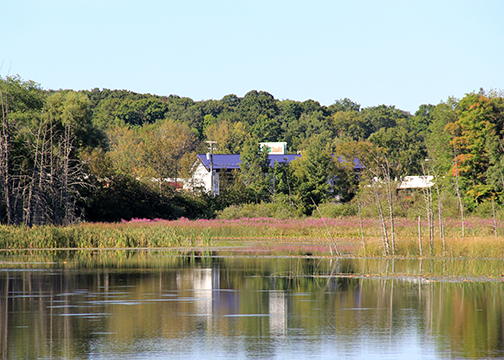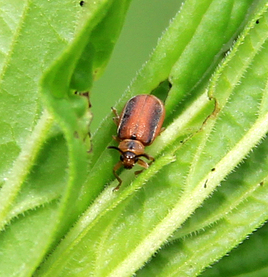*Restricted in Michigan
Overview
Native to Europe and Asia, purple loosestrife can be identified by its purple flowers which bloom from June to September. Purple loosestrife produces square woody stalks 4 to 7 feet high. Leaves are heart or lance shaped and flowers have 5 to 7 petals.
Due to the long flowering season, purple loosestrife plants have the ability to produce millions of seeds each year. In addition to seeds, purple loosestrife can also produce vegetatively by sending up shoots from the root systems. The underground stems can grow up to a foot each growing season.
Table of Contents
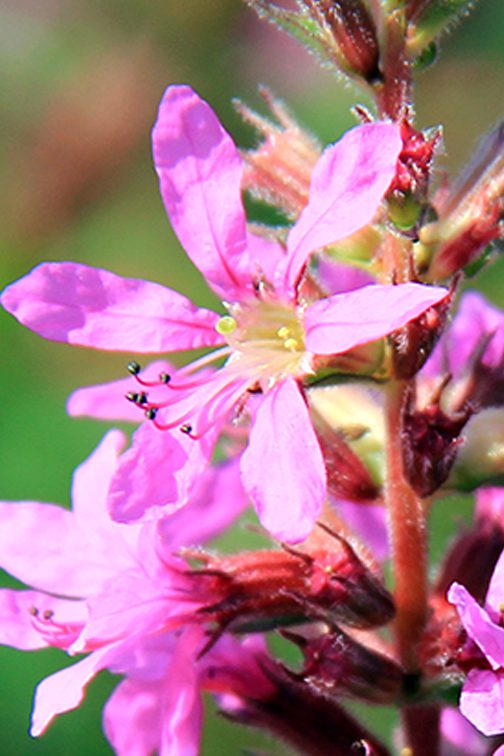
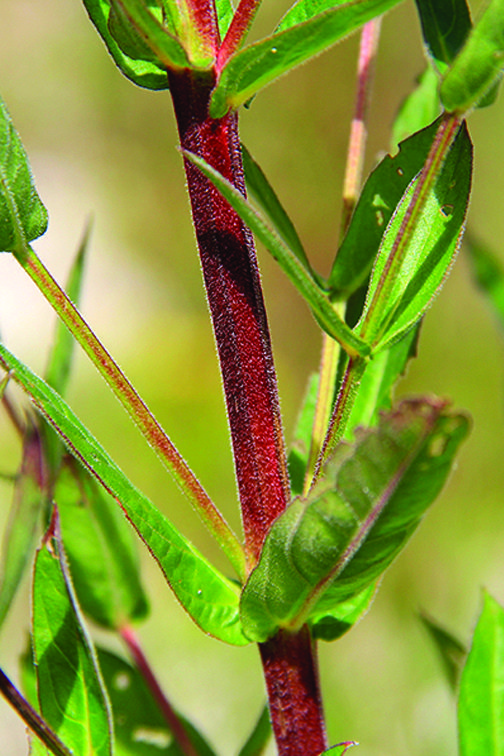
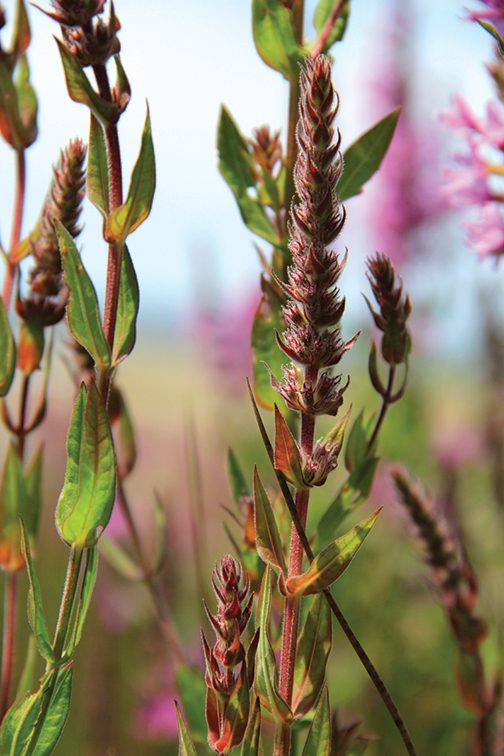
Flowers: Numerous, purple with 5-7 petals; spike-like flowers, two or more per
plant; bloom July through October.
Leaves: Pointed or linear shape; opposite or spiraled around stem; flat to somewhat curved; 1-4 in.; larger leaves at the base.
Stems: Square; smooth or fine-haired.
Fruit and Seeds: Seed pod, small, abundant seed production
Origin & Dispersal
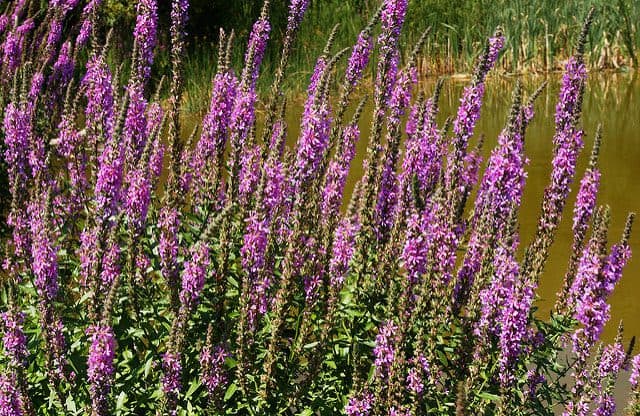
Impacts of Purple Loosestrife Purple loosestrife threatens native species by crowding them out and competing for water and sunlight. When loosestrife replaces native plants, it destroys the habitats of animals and insects that depend on native species for food and shelter. Duck, geese and muskrat populations have all seen declines since purple loosestrife was imported. Dense stands of loosestrife impede water flow and impair the use of wetland recreation areas, in turn requiring costly management efforts. |
For years, conventional ways of dealing with the purple loosestrife problem were tested. For small stands of loosestrife, burning, spraying, and pulling are still the best ways to rid an area of the plants. However, for large stands, such methods are impractical and costly. Controlling the spread of purple loosestrife is crucial to protecting vital fish, wildlife and native plant habitat! Purple loosestrife can easily spread if improper control methods are used. The following simple guidelines will ensure that your efforts to control the spread of purple loosestrife are effective.
Digging & Hand Pulling: Pulling purple loosestrife by hand is easiest when plants are young (up to two years) or when in sand. Older plants have larger roots that can be eased out with a garden fork. Remove as much of the root system as possible, because broken roots may sprout new plants.
Cutting: Removing flowering spikes will prevent this year’s seeds from producing more plants in future years– remember each mature plant can produce over 2 million seeds per year. Also, remove last year’s dry seed heads, as they may still contain seeds. Finally, cut the stems at the ground to inhibit growth.
Chemical Control: The Watershed Council recommends chemical treatment only when other means of control are deemed unlikely to achieve success. It is critical that the correct herbicide is used and applied as recommended for purple loosestrife management.
Biological Control: In areas of severe purple loosestrife infestation, manual and chemical control efforts are ineffective and may in fact contribute to the problem. Luckily, scientists have found an alternative. By introducing a natural predator of purple loosestrife from its native range, wetland protectors have been able to significantly reduce the density of purple loosestrife populations. The Galerucella beetle, which keeps plant populations in check in Europe and Asia, feeds on the stem, leaf, and bud of loosestrife plants, preventing the plant from reproducing. Galerucella beetles have been released in 16 states to date according to the National Parks Service, and the Michigan Sea Grant reported successful depletion of purple loosestrife in Michigan, Ontario, and Minnesota by using Galerucella beetles. |
Additional Things to Consider
- The best time to control purple loosestrife is in late June, July and early August, when it is in flower. Plants are easily recognized, and it has not yet gone to seed. Once flower petals start to drop from the bottom of the spike, the plant begins to produce seed. Control activities can continue during this time, but require greater care so seeds are not shaken from the plant. At sites where plants have gone to seed, remove all of the flowering spikes first by bending them over a plastic bag and cutting them off into the bag. Further cutting of stems or pulling can now take place without fear of spreading the tiny seeds.
- Be aware that your clothes and equipment may transport the small seeds to new areas. Thoroughly brush off your clothes and equipment before leaving the site.
- Keep site disturbance to a minimum. Wetlands provide habitat for many native song birds, waterfowl, mammals, amphibians, and fish which depend on native wetland vegetation. Wetlands are also home to many rare and delicate plants. Take care not to trample or damage native vegetation when controlling purple loosestrife.
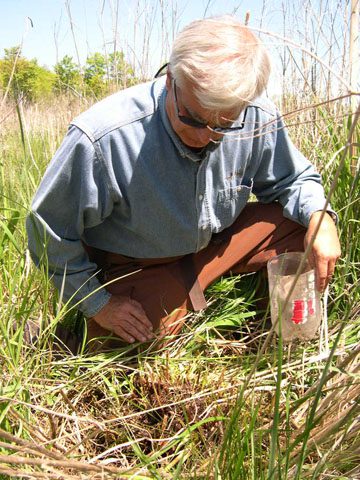
Protecting What You Love Video #11 – Purple Loosestrife This is video #11 in the “Protecting What You Love” series created by Tip of the Mitt Watershed Council. Purple loosestrife (Lythrum Salicaria) is an invasive wetland plant that is beautiful, but dangerous. This aquatic invasive species poses a serious threat to wetlands because of its prolific reproduction. In this video you will learn how to identify Purple Loosestrife and learn about control methods to prevent the spread of this invasive species. Funding for this video was provided by: Charlevoix County Community Foundation Petoskey-Harbor Springs Area Community Foundation Crouse Entertainment Group |
Insert Youtube Video
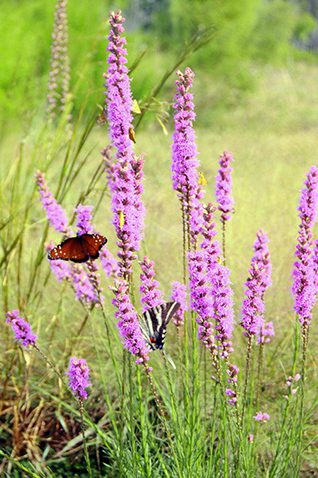
Alternatives to Purple Loosestrife
Several species of garden perennials display characteristics similar to purple loosestrife, yet they pose no threat to our natural environment. The following plants are an example of some of the environmentally-friendly species available at garden centers and nurseries:
- Blazing Star, Gay Feather (Liatris spp.) There are several species of Liatris that are native to North America. Plants grow flowering spikes of blue, pink or purple. Availability and appropriateness of the Liatris species and their varieties will vary in the different geographic areas of North America.
- Delphinium (Delphinium spp.) This traditional perennial grows up to 2m (6′) tall producing a brilliant spike of blue to purple flowers. Individual flowers are about 5-7.5 cm (2-3″) with a single or double ring of petals. Delphinium grows best in full sun.
- Foxglove (Digitalis purpurea) This poplular perennial grows to a height of 1-1.25m (3-4′) and produces masses of bright flowers in a range of colors that bloom in early summer. Foxglove grows best in full sun.
- Lupine (Lupinus) This spectacular perennial provides flowers in a variety of colors ranging from blue to pink and yellow. The flowers form large 0.5m (2′) spikes along the 1-1.75m (3-5″) stem. Lupines grow best with full sun and in well-drained, neutral or slightly acidic soils.
- Salvia (Salvia superba) Salvia is a hardy perennial that is drought resistant and somewhat bug-proof. Most Salvia have blue to violet flowers, appearing as spikes during June and August. Plants grow 0.75-1m (2-3′) tall, preferring full sun and good garden soil.
Additional Resources
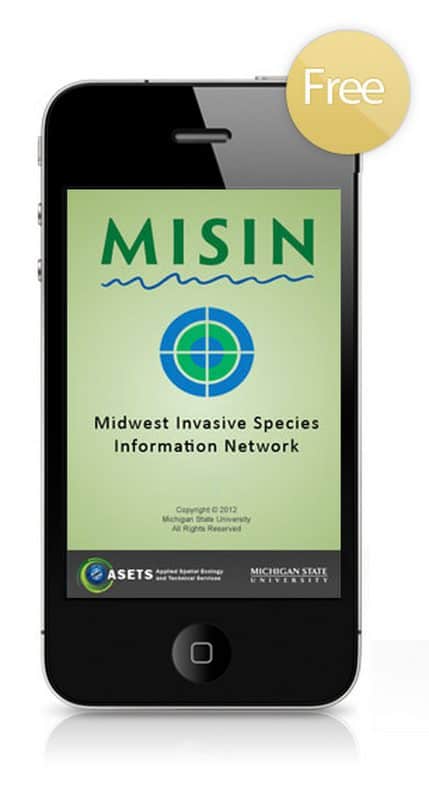
Reporting Invasive Species – FREE APP The MISIN smartphone app provides a mobile solution for the capture of invasive species field observation data. You can play an important role in the early detection and rapid response to new invasive threats in your area by contributing invasive species observations to the MISIN database.
|

